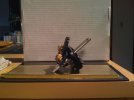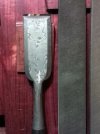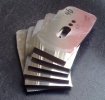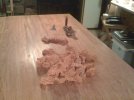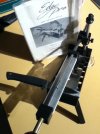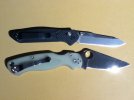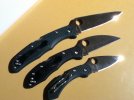During the late 90s I was not only fanatical in my knife hobby but I was also getting into woodworking and learning CNC stuff as well. During that time I was doing business with several vendors to buy tools, supplies ect. One company I really liked doing business with ( and I still do like them) is the Garrett Wade Co. They are mainly a supplier for the woodworking trades but they have always had a wide array of very unique and one of a kind type tools. I've sure filled a couple of tool boxes with stuff I've gotten from Garrett Wade. One set of tools I got from them back during the 9-11 era was a bunch of those Tungsten Carbide sharpening tools. During the early to mid 2000s the TC sharpening tools were getting a lot of trash talk and many guys said that the Tungsten Carbide tools actually damaged cutting edges. However a few people swore by them 
So with all that being said I just kind of "moth balled" all of those TC tools that I had accumulated and would occasionally play with them with limited results. Now lately I've been playing with my F. Dick sharpening steels more than usual and I also tried one of the smooth Tungsten Carbide tools as a sharpening steel of sorts and got some rather interesting results with it fine tuning a knife edge. I've also used the TC tools for rough sharpening jobs with some success. It's been quite a while since I've seen any discussion on Tungsten Carbide sharpening tools so I would like to hear what you all might have to say about them now. Do any of you still have your Tungsten Carbide sharpening tools? If so what results have you had with them? Are there any other uses you've found that the Tungsten Carbide tools ended up working well with? Who has been known to make the better TC tools? OK let's talk about the good and bad that you all have found out about the Tungsten Carbide sharpening tools. During that time period the Garrett Wade Co was known to have good quality TC sharpening tools and I believe they still do>> but are there other companies that offer great quality TC sharpening tools? Because I truly would like to know what the consensus is concerning these Tungsten Carbide sharpening tools. OK let's talk about TC tools
So with all that being said I just kind of "moth balled" all of those TC tools that I had accumulated and would occasionally play with them with limited results. Now lately I've been playing with my F. Dick sharpening steels more than usual and I also tried one of the smooth Tungsten Carbide tools as a sharpening steel of sorts and got some rather interesting results with it fine tuning a knife edge. I've also used the TC tools for rough sharpening jobs with some success. It's been quite a while since I've seen any discussion on Tungsten Carbide sharpening tools so I would like to hear what you all might have to say about them now. Do any of you still have your Tungsten Carbide sharpening tools? If so what results have you had with them? Are there any other uses you've found that the Tungsten Carbide tools ended up working well with? Who has been known to make the better TC tools? OK let's talk about the good and bad that you all have found out about the Tungsten Carbide sharpening tools. During that time period the Garrett Wade Co was known to have good quality TC sharpening tools and I believe they still do>> but are there other companies that offer great quality TC sharpening tools? Because I truly would like to know what the consensus is concerning these Tungsten Carbide sharpening tools. OK let's talk about TC tools


